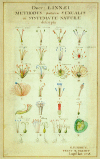Morphogenesis of flowers--our evolving view
- PMID: 15689423
- PMCID: PMC548810
- DOI: 10.1105/tpc.104.030353
Morphogenesis of flowers--our evolving view
Figures


References
-
- Angiosperm Phylogeny Group (2003). An update of the Angiosperm Phylogeny Group classification for the orders and families of flowering plants: APG II. Bot. J. Linn. Soc. 141, 399–436.
-
- Arber, A. (1937). The interpretation of the flower: A study of some aspects of morphological thought. Biol. Rev. 12, 157–184.
-
- Arber, A. (1950). The Natural Philosophy of Plant Form. (Cambridge, UK: Cambridge University Press).
Publication types
MeSH terms
Substances
LinkOut - more resources
Full Text Sources

